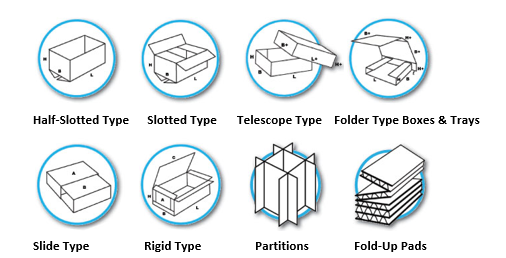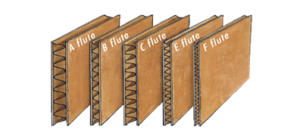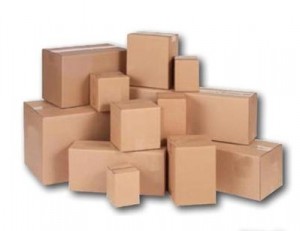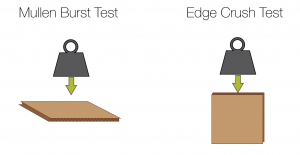*Updated 9-7-17*
Corrugated. Boxes. Cases. Cartons.
Whatever you call them, you see corrugated boxes everywhere. From front porches and distribution centers to moving trucks and manufacturing facilities, corrugated boxes are a part of our daily lives. Just because we all use them, doesn't mean we all understand them. For more facts on corrugated head here.
Corrugated Box Types
 Half-Slotted Boxes: Consist of one piece with a glued, stitched, or taped manufacturer's joint and top and bottom flaps. They are shipped flat, ready to use, and require closing using the flaps provided.
Half-Slotted Boxes: Consist of one piece with a glued, stitched, or taped manufacturer's joint and top and bottom flaps. They are shipped flat, ready to use, and require closing using the flaps provided.
Slotted Boxes: Consist of one piece with a glued, stitched, or taped manufacturer's joint and top and bottom flaps. They are shipped flat, ready to use, and require closing using the flaps provided.
Telescope Box: Consist of more than one piece and are characterized by a lid and/or bottom telescoping over the body of the box.
Folder Boxes & Trays: Usually consist of only one piece of board. The bottom of the box is hinged to form the side walls and the cover. Locking tabs, handles, display panels, etc., can be incorporated in some designs.
Slide Boxes: Consist of several pieces of liners and sleeves sliding in different directions into each other. This group also includes outside sleeves for other cases.
Rigid Boxes: Consist of two separate end pieces and a body and require stitching or gluing of fiberboard or wood.
Partitions: Interior fitments such as inside liners, pads, separators, dividers, etc. , whether tied to case design or as singular items. Any shown number of panels is arbitrary and may be increased or decreased, as required.
Fold-Up Pads: Interior fitments such as inside liners, pads, separators, dividers, etc. , whether tied to case design or as singular items. Any shown number of panels is arbitrary and may be increased or decreased, as required.
This refers to the wave shapes, or ridges, that are pressed into a sheet of material that has been softened by steam. This material is then sandwiched between flat sheets of material to form corrugated fiberboard. Flutes serve as protective cushioning and help strengthen a carton. Different widths and configurations offer distinctive performance advantages. Corrugated cartons feature either of the types below.
- A-Flute: Flute thickness of 4.7 mm

- B-Flute: Flute thickness of 2.5 mm
- C-Flute: Flute thickness of 3.6 mm
Depending upon the stacking strength, puncture resistance, and crush strength required for the carton; one of the above three commonly corrugations are used in single-wall, general-purpose cartons. A-Flute has excellent stacking strength, B-Flute has good puncture resistance, and C-Flute has the optimum combination of both.
- E-Flute: Flute thickness of 1.5 mm and is generally used for light applications such as pizza boxes, mailers, shoe boxes, etc.
- BC Flute: This flute is a double-wall combination made from one B-flute, single-wall sheet and one C-flute, single-wall sheet. The result is a strong corrugation used when extra thickness or stacking strength is needed.
- AC Flute: This flute is a double-wall combination made from one A-flute, single-wall sheet and one C-flute, single-wall sheet. The result is a very strong corrugation used when extra strength is needed.
Basis Weight Testing: A measurement of mass per unit of area that is expressed in pounds per thousand square feet. Basis weight is used to describe linerboard, corrugating medium, and boxes.
The Mullen Burst Test- Measures bursting strength of the corrugated board. The Mullen test presses a rubber diaphragm bubble against the board in a defined area to measure the pounds of pressure per square inch (psi) ti takes to burst the board. Many customers like Mullen tested boxes for the protection of heavier contents because they are concerned about the linerboard bursting outward.
ECT (Edge Crush Test)- Measures the box board’s top-to-bottom compression strength (also known as stacking strength). This test looks at two areas of strength: box compression strength (BCT) and stacking strength. If a customer is concerned about the maximum weight a box can withstand, then ECT is your test. Today, this is the most common type of test used.
ISTA Testing: Performance testing specified by the International Safe Transit Association. Generally includes testing of shock and vibration effects on packaging.
HAZMAT/UN Testing: Shipment of dangerous goods or hazardous materials are highly regulated. Based on the UN Recommendations on the Transport of Dangerous Goods model regulations, each country has coordinated design and performance requirements for shipment.
General Corrugated Definitions
Broke: Paper trimmings, paper damaged due to breaks on a paper machine, or paper not manufactured to the required quality specification. Broke is usually fed back into the paper manufacturing process.
Carton Dimensions: Dimensions refer to the interior of a carton - length x width x height - and measured in millimeters. Length (L) is the longer side of the opening and width (W) is the shorter. Height (H) is the length between the openings on either end.
Cellulose: The main fibrous material in paper.
Corrugated Fiberboard: This material refers to the composite structure formed by gluing one or more sheets of fluted, corrugated material to one or more flat facings of linerboard.
- Single-wall carton: This is a corrugated fiberboard carton made by gluing a sheet of fluted corrugated material between two flat sheets of linerboard.
- Double-wall carton: This is a corrugated fiberboard carton made of three sheets of linerboard interleaved with two sheets of fluted corrugated material.
Die Cutting: The process of cutting a corrugated sheet into a shape which will convert to the required box size when assembled. A rotary die cutter uses a cylindrical die and is generally capable of higher speed than a flatbed die cutter, as the sheet flow basically continues. A flatbed die cutter uses a flat die. The corrugated sheet momentarily stops to enable the required cutting. This method provides both high accuracy and intricate shapes not available from the rotary process.
Double-facer: A double-facer, or double backer, is the part of a corrugator which bonds single-face board to another liner. This produces a double-faced corrugated sheet.
Folding Cartons: Multi-layer paperboard cartons which are printed or coated and cut into carton blanks. The carton blanks also incorporate creases, which enable the carton to be formed for packaging the customer’s product.
Functional Coatings: The lamination of polyethylene and/or plastic or foil films to paper substrates, providing a water or grease-proof barrier. Typically used in high humidity applications in both tropical and cold temperatures. Also for use with meat, seafood, pet food, fruit, and produce.
Kraft: This term describes the natural, unbleached corrugated fiberboard used in making cartons.
Linerboards: Linerboards form the inner and outer facings of corrugated fiber boxes and are chosen for their structural and/or decorative properties. They can be made from white or brown, kraft or recycled fibers, or a blend of both.

Pasting: Two, three, or four plies of paper and paperboard are glued together. They form a solid fiberboard with a thickness ranging between 0.8mm to 3mm. The boards are used for a variety of applications. Shoe boxes, screen printing, display boxes, board games, book covers, and ring binders.
Pulp: Primary raw material from which paper is made. A fibrous product produced by mechanical or chemical processes, or a combination of both.
RSC: This is the abbreviation for regular slotted carton. This is the most commonly used style of carton. One side is glued, taped, or stapled during manufacturing. This type of carton is well suited for easy set-up, filling, and closure.
Sheet Feeder: A corrugating plant that has no converting equipment and produces only corrugated sheet. Its customers are typically independent sheet plants. The term ‘sheet feeder’ can also mean the device at the front of die cutters/flexo folder gluers.
Sheet Plant: Comprises converting equipment and does not produce its own corrugated board. Typically, sheet plants are smaller operations offering their customers personalized service.
Read more corrugated resources:
- Corrugated Rules and Regulations
- Case Sealing Automation
- What do I need: Behind the Scenes for Boxes
- IPS Packaging: Boxes and Corrugated Sheets
Follow our Knowledge Base for the latest blogs on packaging supplies, equipment, case studies, and more ways to save money.
Follow us on LinkedIn, Twitter, and Facebook and click those share buttons below if this post helped you.




